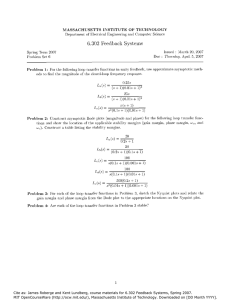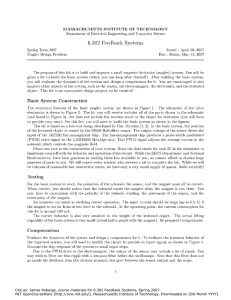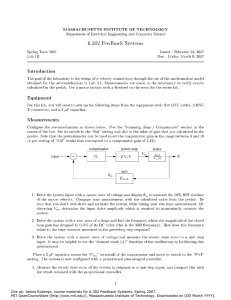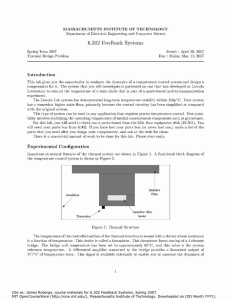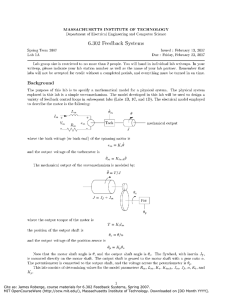MASSACHUSETTS INSTITUTE OF TECHNOLOGY 3 Cornpllt,er Science
advertisement
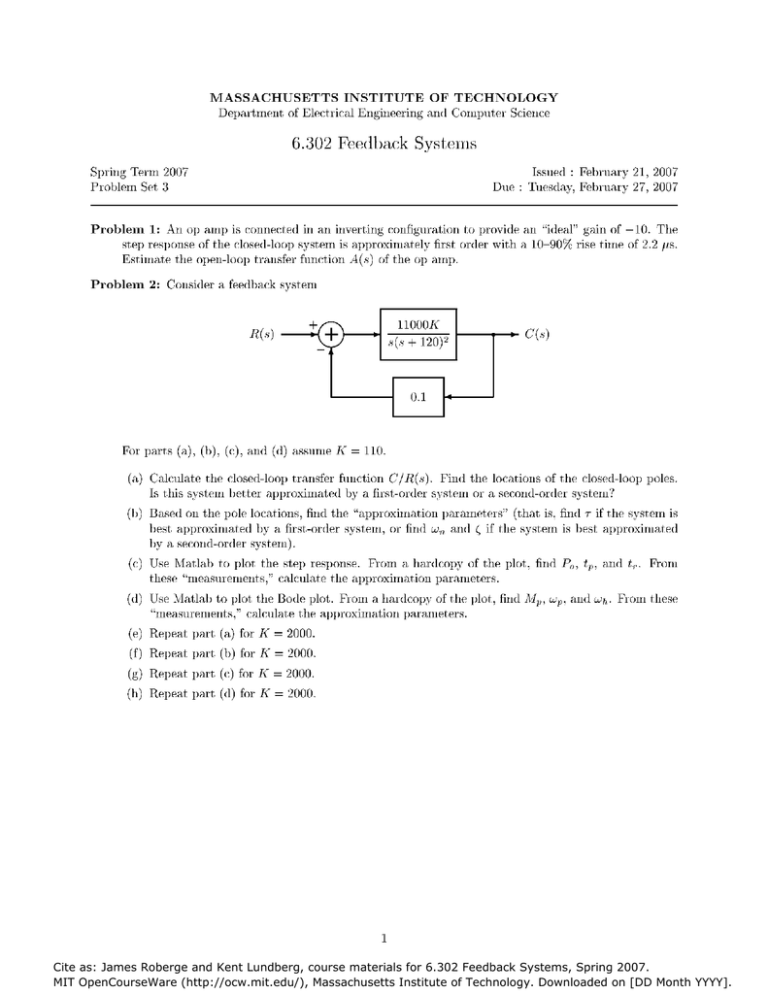
MASSACHUSETTS INSTITUTE OF TECHNOLOGY
Depart,rnent of Electrical Engineering ar~rlCornpllt,er Science
Spring Terrr~2007
Prol~lernSet 3
Problem 1: .in o11 arr111 is connr<:tr(iin an irlvertir~gcn~~figllrat,inr~
tn provi(ie a11 .'i(iealli gain of -10. The
step response of the closecl-loo11systerrl is approxir~~r%tely
first nrder wit11 a l0-90% rise tirr~enf 2.2 11s.
Estirrlat,e t , l ~ ope11-1oo~1
r
A(s) of the 011 arnp.
trar~sferfilr~ct,ior~
Problem 2: Consicler a. frerll~acksystrrn
For parts (a), (I]), (c), and ((i) assllrrle Ii = 110
(a) Cal<:l~latr
t l ~ ecloserl-loop trar~sfrrfilr~ct,ior~
C/R(s).
Find t , l ~ rlocatior~sof t l ~ eclosecl-loo11 poles.
Is t l ~ i ssyst,ern 1)ettrr approxirr~at,e(lI1y a first,-order syst,ern or a srconcl-orrlrr systrrn? (I)) Based on t , l ~ pole
r
lo<:ations,find t , l ~ r"approximation pararnet,ers3' (that is. find T if t l ~ esysterrl is
I~estapproxirnatr(i 11~7a first-orrlrr syst,err~,or fir111w, ar~rl if the systerrl is Ilest approxir~~r%te(i
11~7a srconcl-orrlrr systrrn).
<
( c ) Use hlatlal] to plot the st,ep response. Frorr~a hardcopy of t l ~ eplot,. fir111Po, t,, a1111 t,.. Frorn tl~ese' . I I I ~ ~ S ~ I ~ ~ I(:r%l<:l~lr%te
I I ~ I I ~ Sthe
, " a ~ ~ ~ ) r ~ x i r pr%rr%rIleters.
r~atic~~~
((i) Use \Iat,lal) t,o plot t , l ~ Bncle
r
plot,. Frorr~a hardcopy of t l ~ eplot, find ATrl, w,.
"rneasl~rrrnents,"calclllate t l ~ eapproxirr~at,ion~ ~ararneters. and d,,,. Frorr~tl~ese (e) Reprat part (a) for IC = 2000.
(f) Reprat part (11) for I1 = 2000,
(g) Reprat part (1:) for Ii = 2000.
(11) Reprat part ((1) for I1 = 2000,
Cite as: James Roberge and Kent Lundberg, course materials for 6.302 Feedback Systems, Spring 2007.
MIT OpenCourseWare (http://ocw.mit.edu/), Massachusetts Institute of Technology. Downloaded on [DD Month YYYY].
Problem 3: .i
~~nity-fee(it)a(:k
syst,errl llas a. loop trarlsfer fim(:tion giver1 t)y
(a) For a. unit-stell input,. t l ~ eclosecl-loo11 response rrlllst have a peak overslloot of 16%). Deterrrlir~e
va111e of Ii.
t11e req~~ire(i
(I)) If I< = 2, \%-hatis tlle approxir~lr~te
rise t , i r ~ nf
~ ethe n ~ l t p l ~
~ ~t S I I O I t,n
I S ~a step i~~pl~t,'!
( c ) If I< = 2 and tlle i r l p ~ is
~ ta 1111itra1r111, \%-hatis tlle st,eacly-stat,e error?
Problem 4: For the block diagrams giver1 in Figures 1 ~ L I I (2,~ f;n~r~pr%re
the effect nf the locatinr~nf the
integrat,or on tlle stallility arlrl stea(iy-state errors for step and rarrlp i n p ~ ~of
t s t )
o t l ~inpl~tR arlrl D.
Express and cornpare all of t,lle stearly-st,ate errors:
(a) How (in t,llese errnrs f ~ Rr r~rldD (:ornpare for t l ~ esyst,ern sllorvr~in Figure 1'!
(I)) How (in t,llese errnrs c n ~ r ~ p rfor
~ r ethe
syste111 S~IOTVIIi11 Figure 2Y
( c ) Explain t,llese (lifferen(:esin I~ehavior.
Figure 1: St,ea(iy-state error systerrl 1
D
I
Figure 2: St,ea(iy-state error systerrl 2
Cite as: James Roberge and Kent Lundberg, course materials for 6.302 Feedback Systems, Spring 2007.
MIT OpenCourseWare (http://ocw.mit.edu/), Massachusetts Institute of Technology.Downloaded on [DD Month YYYY].
Problem 5: Consicler the following loop trarlsfer filnct,ions:
For each loop trarlsfer fi~nct,ion:
(a) Plot an asyrr~ptot,icBncle Plot.
(I)) Find t l ~ e rror t,rar~sferfim<:tion,assllrr~ir~g
illat t,lle al~oveloop t,rar~sferfim<:tionsrlescri1)e oparr~p
circuits \%-it,h1111it,yfeerll~ack.
( c ) Find t,lle stearly state error to a. 1 \' stel) i ~ ~ p u t , .
((i) Find t,lle stearly state error to a. 1 \'Is ramp i n p i ~ t .
Problem 6: .i linear syst,ern may t)e st,at)lefor <:ert,aininput,s and imst,at)lrfor ot,ller input,s. True or false?
J i ~ s t i fyour
j ~ ans\%-er.
Problem 7: This shoi~lcll ~ ceornplet,ecl ilsirlg Oct,ave. M.iTL.iB or sirrlilar softsrare. You rrlaji find it helpfill
to stwe $0111 mnrk as it may l ~ lelsefill in the fi~t,l~re.
Please hand in 1:learly lal)elle(iprintoi~ts.
The ~ I I I I I O S Pof illis prnI11e111is tn i~lvest,igr%t,e
the r e l t % t i o r ~ ~
I)etweer~
l ~ i ~ ~ tirr~eand freqilen<:yresponses
of lirlear systerns. Prorli~cea t,at)le with the trarlsfer fim<:tion arlrl expressions for t,lle rise tirne, t l ~ e
t)an(isvi(ith. rnagnitil(ie ~ ~ e a k i npeaking
g,
freqilen<:y.peak overshoot, tirr~eto peak. arlrl t,lle 2% set,tling
tirrle for t,lle follosrir~glirlear syst,errls.
First order syst,err~.
1
HI (s) = 7s + 1
Seconcl order systern.
. ,a
H'(s) =
2<d,,,
.S"
+
d:
Kosr prorli~cet,lle reql~ireclplot,s for the Secorlrl order systern only. \%-it,hthe following set of srahles:
d,,
held <:onstanta t 5 111s and five srt~lilesof
< = 0.5 and five valiles of w,
<dl,=
< frorr~0.1 t,o 1 inchlcling 0.707.
frorr~2 t o SO (excli~rlingd,,,= 5).
2.5 for five (iifferent valiles of
< or
d,,
(that is, if
< = 0.2, w,
= 2.510.2 = 12.5)
<
~ ~ r n d i l cthe
e following plot,s (first iterr1 lister1
Y ~ Isl~ol~lrl
I
rlow ht~ve15 - d,,,pairs. 11-ith tllese s~t~liles
shoi~lcll )e on the x-&xis). Each plot sl~ol~lrl
hasre 15 data ~ ~ o i n t s .
1.
< v% h h g r ~ i t i ~ rPeaking.
le
2. hlagr~itilrlePeaking vs. Peak Overshoot
3. Rise Tirr~evs. Banrlmirlt,h.
Cite as: James Roberge and Kent Lundberg, course materials for 6.302 Feedback Systems, Spring 2007.
MIT OpenCourseWare (http://ocw.mit.edu/), Massachusetts Institute of Technology. Downloaded on [DD Month YYYY].
Problem 8: klatch each step response (1-8) t,o t l ~ eappropriate Bode rnagnit~~de
plot ('4-H).
slope = -1
log d
slope = -2
log d
3
log d
r\,
log d
1,
log d
I
H
not to scale
Cite as: James Roberge and Kent Lundberg, course materials for 6.302 Feedback Systems, Spring 2007.
MIT OpenCourseWare (http://ocw.mit.edu/), Massachusetts Institute of Technology. Downloaded on [DD Month YYYY].


